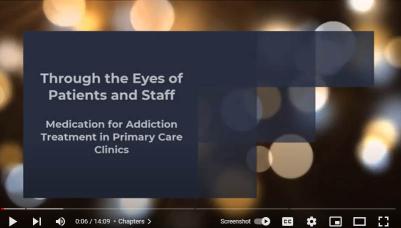Exploring the Use of Both Medication and Behavioral Health Care to Treat Opioid Use Disorder

Opioid use disorder persists as one of the largest epidemics in America. During the 12-month period ending in October 2021, the estimate of total overdose deaths was nearly 106,000, according to provisional data from the Centers for Disease Control and Prevention. This 12-month lookback estimate has been above 100,000 since April 2021, the first time the rate reached 100,000 deaths. These data indicate a need to examine how this disorder is treated.
The most common and evidence-based approach to opioid use disorder treatment focuses on the use of three medications approved by the Food and Drug Administration: methadone, naltrexone, and buprenorphine. While current evidence supports use of medication on its own as effective in treating opioid use disorder, treatment guidelines recommend offering behavioral counseling as well.

This can be accomplished through integrated care, where physical and behavioral health treatments are offered in the same setting. In this model, individuals receive comprehensive treatment to address their biological, psychological, and social needs. A wide range of health professionals, including physicians, nurses, psychologists, social workers, and peer support specialists, collaborate to offer cohesive, holistic treatments. Research shows a number of benefits to an integrated approach to treating opioid use, though there are several barriers preventing its more widespread uses. In this piece, we examine what the research shows about using integrated care to treat opioid use and explore ways decisionmakers can potentially expand it.
Benefits of an Integrated Approach
Research has found that collaborative care interventions can be effective in helping initiate treatment for opioid use disorder. Further, a randomized controlled trial found that individuals had higher levels of abstaining from substances 30 days after initiating treatment in integrated services, compared with typical models of care.
Another potential benefit of an integrated approach is a reduction in the stigma that surrounds substance use and behavioral health treatment. In integrated care, mental and physical health services tend to be located in the same setting. Because of this co-location, individuals with opioid use disorder may experience less stigma when they seek mental health care. Especially in smaller communities, visiting a primary care treatment center may feel more acceptable for people who are reluctant to visit a mental health center.
Integrated care also may affect costs. People with substance use disorder typically have high use of health care services, which tends to increase costs for both the individual and the health system. Research has shown that counseling plus buprenorphine leads to reduced use of general medical services and significantly lower health care costs than little or no treatment among commercially insured patients with opioid use disorder.
Barriers to Expanding Use of Integrated Care
Despite evidence linking integrated care to improved health outcomes and patient experiences, various economic and logistical barriers prevent health care professionals from providing comprehensive care. Here are a few of those obstacles.
- Reimbursement and Billing: Many health care providers find the reimbursement process for integrated care difficult to navigate. For instance, some state Medicaid programs have restrictions on billing for both physical and behavioral health services provided on the same day.
- Workforce Availability: While there is a wide need for behavioral health specialists, there is a particular need for those working in substance use disorder treatment services. Many practices find it challenging to find providers with training in opioid use disorder treatment or to persuade providers to work in rural areas.
- Policies and Procedures: Treatment policies may prevent providers from prescribing buprenorphine, a medication to treat opioid use disorder that can be prescribed in physician offices. Federal policy requires prescribers to obtain approval to prescribe buprenorphine, in the form of an “X waiver,” which mandates time-consuming trainings for physicians, nurses, and physician assistants. Regulatory changes in 2021 allow qualified providers to treat up to 30 patients without completing the training requirement.
Approaches to Improving Access to Integrated Care
Integrated care offers health professionals the opportunity to reimagine typical opioid use disorder treatment and take a whole-person approach. Stakeholders interested in expanding the use of integrated care to treat opioid use disorder could consider the following actions:
Integrated care offers health professionals the opportunity to reimagine typical opioid use disorder treatment and take a whole-person approach.
- Addressing financial barriers: Health care practices looking for funding to provide integrated care can look to state, federal, and foundation grants, which have become increasingly available. The 2018 SUPPORT Act requires federal agencies, such as SAMHSA, CDC, and HHS, to provide grant funding to address the opioid crisis. Recently, SAMHSA announced over $123 million in funding through six grant programs to address the rise in overdoses. Medicaid also has made changes to support integration through new billing codes around time-based patient management costs and general behavioral health.
- Employing telehealth services: Virtual treatment can help address scheduling and workflow concerns in an integrated practice, as well as issues around access. Using telehealth, especially in rural areas, could expand the pool of qualified staff to serve hard-to-reach populations. Research has shown that telehealth helped maintain patient engagement in opioid use disorder treatment during the COVID-19 pandemic. Medicare reimbursement policies currently cover telehealth, although some services will not be reimbursable once the Public Health Emergency Declaration ends.
- Adding a behavioral health provider into the primary care setting: A variety of practitioners besides psychiatrists can provide behavioral services. For instance, social workers and peer support specialists help expand the provider pool. Health care practices could consider strategically using existing staff at their highest level of expertise and hiring based on gaps in services, such as prescribing authority or ability to provide counseling services.
- Applying for an X-waiver: New guidelines from SAMHSA state that eligible practitioners may dispense or prescribe buprenorphine to treat opioid use disorder to 30 or fewer patients without completing a training requirement to obtain the waiver. The new guidance aims to decrease barriers to initiating opioid use disorder treatment. Training is still required to prescribe this medication to more than 30 individuals.
Research confirms the benefits of an integrated care model for individuals with substance use disorders on both an individual and community level. An important next step is to spread awareness of these findings to practitioners and policymakers, in order to reduce barriers to this treatment and make these programs more widely available.